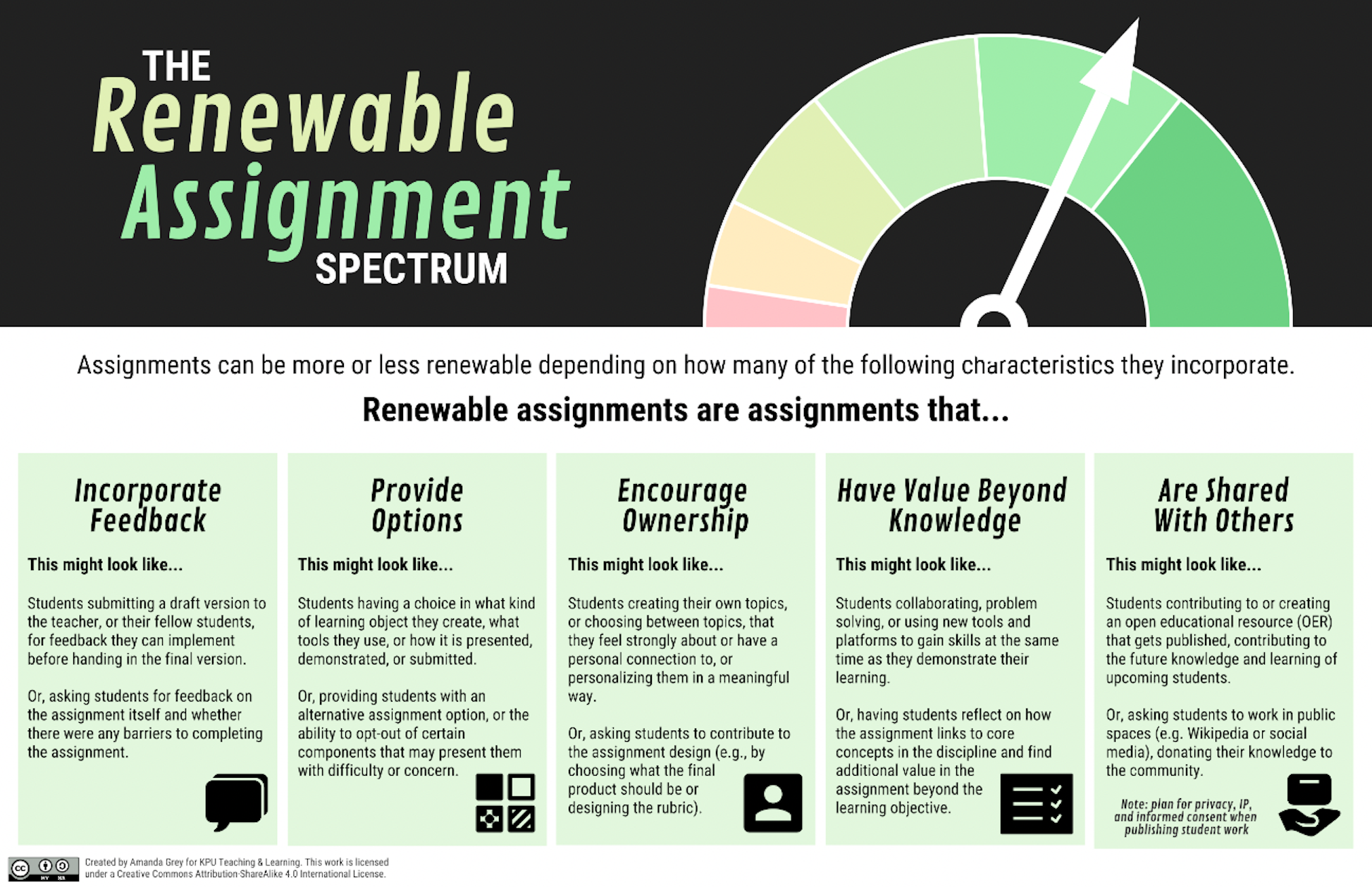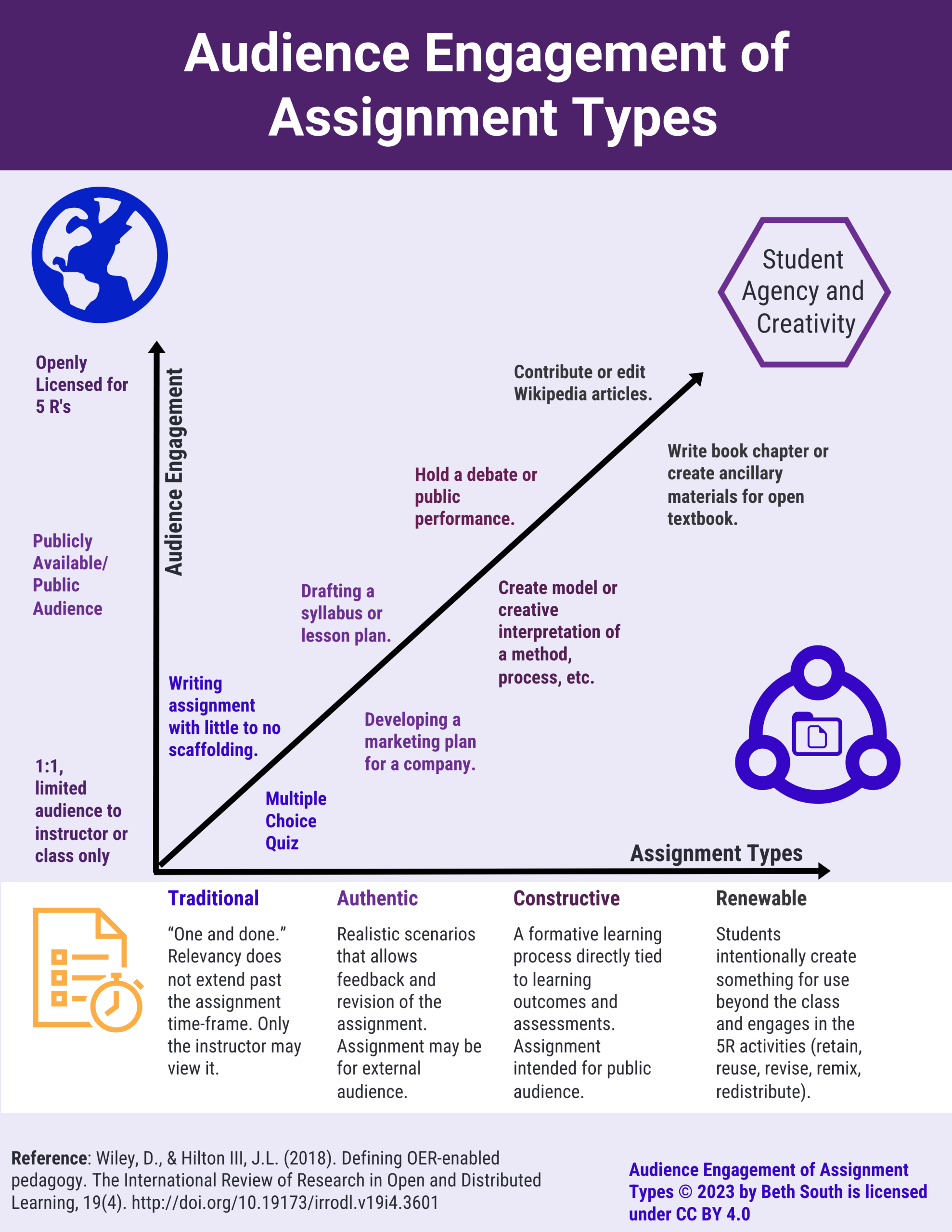What is Open Pedagogy? Why should we consider using it?
Christine Rickabaugh
What is Open Pedagogy?
Great question! Unlike other educational concepts, there is no definitive definition of open pedagogy or open educational practices. Tietjen & Asino (2021) identified 12 (slightly) different definitions of open pedagogy or open educational practices published between 2011 and 2020[1].
For our purposes, we are defining open pedagogy as projects or assignments that have the characteristics of:
- engaging with students as creators of information rather than simply consumers of it;
- experiential learning in which students demonstrate understanding through the act of creation;
- inviting students to be part of the teaching process/participating in the co-creation of knowledge;
- moving away from single-use assignments in favor of situated, collaborative, and renewable ones;
- student agency in deciding if and how their work is shared[2]
What happens when an assignment or project is over?
Traditional (Disposable) Assignments: Traditional (non-open-pedagogy) assignments “are often very transactional in nature, seen only by the instructor for the purpose of demonstrating content mastery and achievement of learning objectives[3]”. These transactional assignments, in the light of open pedagogy, are labelled as “disposable” due to their non-existent life span after completion, disconnection from other course content or assignments, and lack of student agency.
Examples of disposable assignments:
-
-
-
- Discussion boards (e.g., students write one post and reply to X others).
- Deliverables that get pitched after class (e.g, printed posters).
- Reflections without connections to course materials or a lack of transparency for why they matter.
- Learning objects (e.g., essays, videos) that are only seen by the student and the instructor.
- Assignments that feel like busy work[4].
-
-
The Renewable Assignment Spectrum
When applied to assignments, open pedagogy tends to display five different characteristics: incorporating feedback, providing options, encouraging ownership, having value beyond knowledge, and being shared with others. These characteristics can appear singly, be used together, or have significant overlap. Renewability is a spectrum depending on how many of the characteristics are present, which provides room to choose which ones align best with the learning objectives of a course and classroom culture.

Why should we consider using it?
What do we know about our students? If it’s going to be shared, they’re likely to care more.
- Open Pedagogy improves access to education, but this is access broadly writ.
- Open Pedagogy treats education as a learner-driven process.
- Open Pedagogy stresses community and collaboration over content.
- Open Pedagogy connects the academy to the wider public.[5]
- Open Pedagogy has been shown to enhance intrinsic motivation in students.
- Students reported higher rates of interest/enjoyment, perceived choice, and perceived competence when comparing renewable assignments to traditional assignments[6].
Open educational practices invite opportunities to highlight resources, experiences, or perspectives that might not otherwise be represented[7]. It gives students agency to present information in the manner that makes the most sense to them. It offers the experience of authentic assessment, in which we ask students to engage in the type of work they’ll likely be doing in the field. It also enables the creation of artifacts that demonstrate their career-ready skills.

Content for this chapter was remixed from The Texas Open Pedagogy Core Elements Course by Kate McNally Carter, licensed under a Creative Commons Attribution 4.0 International License, except where otherwise indicated.
- Tietjen, P. & Asino, T. (2021). What Is Open Pedagogy? Identifying Commonalities. International Review of Research in Open and Distributed Learning, 22(2), 185–204. https://doi.org/10.19173/irrodl.v22i2.5161. This work is licensed under a CC BY 4.0 license. ↵
- "The Open Pedagogy Project Roadmap" by Christina Riehman-Murphy and Bryan McGeary, is licensed CC BY-NC 4.0. ↵
- Clinton-Lisell, V. & Gwozdz, L. (2023). Understanding Student Experiences of Renewable and Traditional Assignments. College Teaching, 71(2), 125-134. https://doi.org/10.1080/87567555.2023.2179591 ↵
- Larson, Amanda. (2023). Disposable vs. Renewable Assignments [Presentation]. Open Pedagogy Learning Circles. Open Education Network. ↵
- DeRosa, R. (2017, January 23). Extreme makeover: Pedagogy edition. Actualham. https://robinderosa.net/higher-ed/extreme-makeover-pedagogy-edition/ ↵
- Clinton-Lisell, V., & Gwozdz, L. (2023). Understanding student experiences of renewable and traditional assignments. College Teaching, 71(2), 125–134. https://doi.org/10.1080/87567555.2023.2179591 ↵
- Bali, M. (2016, September 4). Reproducing marginality? Reflecting Allowed [blog]. https://blog.mahabali.me/pedagogy/critical-pedagogy/reproducing-marginality/ This work is licensed under a CC BY-NC 4.0 license ↵

